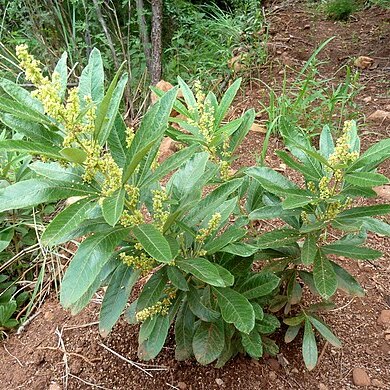Branches and petioles tomentose and hirsute; leaves petiolate, leaflets sessile, lanceolate, mucronate, quite entire, adpressed-pubescent, or sub-glabrous above, softly reddish-tomentose below, flat or with revolute margins, the terminal tapering at base; panicles hirsute, the axillary shorter than the leaves, the terminal longer, many-flowered; drupe globose, glabrous, shining. Very near the preceding, but differs by the soft, reddish tomentum, the sessile leaflets, shorter racemes and drupe. Petioles 3-6 lines long. Leaves about 3 inches long, 6-8 lines wide, acute or obtuse, mucronate, the lateral ones unequal at base. Drupe yellowish brown, the size of a small pea.
Shrub or dwarf shrub, 0.2-1.0 m high; virgate to branched suffrutex; branches pubescent, shallowly ribbed. Leaves petiolate, trifoliolate; leaflets sessile, subcoriaceous, greyish green, sericeous to strigose above, greyish white to cream-coloured below, broadly linear, oblanceolate, narrowly elliptic or obovate, margins entire, revolute. Inflorescence much-branched panicles, pubescent, axillary and terminal, crowded towards branch ends; males up to 140 mm long, exposed. Flowers: pedicle and calyx pubescent; styles persistent. Flowering time Nov.-Mar. Fruit a drupe, circular to oblate, glabrous, shiny, dull yellowish brown.
A shrub. It has erect, tufted, unbranched shoots. It grows up to 50 cm high. These arise from a woody base. The leaves are erect and the leaf stalks are 5 mm long. The leaflets are oblong and blunt but with a small point. They are 8 cm long by 1.7 cm wide. The veins are prominent underneath. The flowering stalks are at the ends and along the sides. They are hairy.
Suffrutex, up to 1 m high. Leaflets sessile; whitish tomentose below; blade broadly linear, oblanceolate, narrowly elliptic or obovate, margins entire, revolute; terminal leaflet (18-)82 (-131) x (4-)18(-35) mm. Flowers: corolla pale yellow to green; Sep.-Feb. Fruit a globose, glabrous drupe.
Suffrutex, up to 1 m high. Leaflets whitish tomentose below; lamina broadly linear, oblanceolate, narrowly elliptic or obovate; terminal leaflet (18-)82(-131) x (4-)18(-35) mm. Flowers pale yellow to green.

